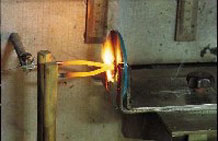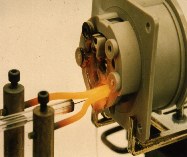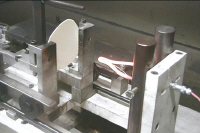Glow-wire flammability test | Glow-wire flammability test according to IEC 60695-2
(edition October 2000)
The glow-wire test is one of the most important fire tests for electrical and electronics applications. It simulates glowing wires inside component assemblies, which can occur as a result of overloading and produce extreme temperature peaks.

 | | The test being performed | The glow-wire test takes in three procedures of practical relevance:

- Glow-wire test of end-products according to IEC 60695-2-11 (GWT: Glow-Wire-Temperature)  | Test conditions
Glow-wire temperatures:
Penetration force:
Penetration depth:
Penetration time ta: |
550, 650, 750, 850, 960 °C
1.0 N ± 0.2 N
max. 7 mm
30 s ± 0.1 s |

Measured values:
- Burning time: te
(Time from the beginning of penetration of the wire
to the moment when the flame goes out during or
after the penetration time.)
- Dripping of burning drops or glowing parts. | Test has been passed if:
- no flame / no glowing
or
- burning time te ≤ ta + 30 s
(flames or glowing parts go out within 30 s of
removal of the glowing wire)
and
no ignition of the cotton |


When the test is conducted on the finished part, it is not only the material itself that is tested. The design and any metal inserts will also influence the results.
The standard additionally makes provision for two tests that can be used for assessing dissimilar materials; these are both conducted on plaques.

- Glow-wire test with plaques according to IEC 60695-2-12 (GWFI: Glow-Wire-Flammability-Index) IEC 60695-2-12 states that "the test results make it possible to provide a relative comparison of various materials according to their ability to extinguish flames on removal of the electrically heated glow-wire and their ability not to produce flaming or glowing particles capable of spreading fire to a specified layer of wrapping tissue placed below".

| | Test conditions
Glow-wire temperatures: 550, 600, 650, 700, 750, 800, 850, 900, 960 °C |  |
Penetration force:
Penetration depth:
Penetration time:
Specimen: Plaque
Dimensions:
Thickness: |
1.0 N ± 0.2 N
max. 7 mm
30 s ± 0.1 s
60 mm x 60 mm
0.75, 1.5, 3.0 mm |


Highest temperature which fulfills, in three successive tests, one of the following conditions:

- No ignition of the plaque
- Burning time or glowing time ≤ 30 s after removal of the wire and no ignition of the cotton.

Example for a specimen (thickness 3 mm) at 850 °C: GWFI: 850 / 3.0

- Glow-Wire test with plaques according to IEC 60695-2-13 (GWIT: Glow-Wire-Ignition-Temperature) IEC 60695-2-13 states that "the test results make it possible to provide a relative comparison of various materials according to the temperature at which the test specimen ignites during the application of the electrically heated glow-wire used as an ignition source."

| | Test conditions
Glow-wire temperatures: 550, 600, 650, 700, 750, 800, 850, 900, 960 °C
Reduce interval of test temperatures to 25 K (30 K for 960°C) in the final approach. |  |
Penetration force:
Penetration depth:
Penetration time:
Specimen: Plaque
Dimensions:
Thickness: |
1.0 N ± 0.2 N
max. 7 mm
30 s ± 0.1 s
60 mm x 60 mm
0.75, 1.5, 3.0 mm |


GWIT: Glow-wire ignition temperature, which is 25 K (30 K between 900 °C and 960 °C) higher than the maximum glow wire temperature which does not ignite the plaque during three successive tests (during penetration of the glowing wire). Glühdrahtes). Ignition: Burning time with flame ≥ 5 sec
Example for a specimen (thickness 3 mm) and a maximum glowing wire temperature of 825 °C, which does not ignite the plaque: GWIT: 850 / 3.0

| | | |

